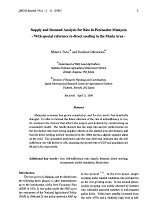Supply and Demand Analysis for Rice in Peninsular Malaysia -With special reference to direct seeding in the Muda Area-
JIRCAS Journal
| ISSN | 13407686 |
|---|---|
| NII recode ID (NCID) | AA11030483 |

Full text
jircas_journal2-_1-11.pdf614.53 KB
Malaysian economy has grown remarkably, and the rice sector has drastically changed. In order to forecast the future direction of the rate of self-sufficiency in rice, we analyzed the factors that affect the supply and demand by constructing an econometric model. The results showed that the wage rate and per capita income are the key factors that exert strong negative effects on the planted area and demand, and that the direct seeding method introduced in the 1980s exerts a slightly negative effect on the yield. The simulation performed until the year 2003 year indicates that the self-sufficiency rate will decline to 55%, assuming the growth rate of GDP and population are 8% and 2.5%, respectively.
| Date of issued | |
|---|---|
| Creator | Minoru TADA Yoshinori MOROOKA |
| Subject | rice self-sufficiency rate supply demand direct seeding econometric model simulation Muda Area |
| Publisher | Japan International Research Center for Agricultural Sciences |
| Available Online | |
| NII resource type vocabulary | Journal Article |
| Volume | 2 |
| spage | 1 |
| epage | 11 |
| Rights | Japan International Research Center for Agricultural Sciences |
| Language | eng |
